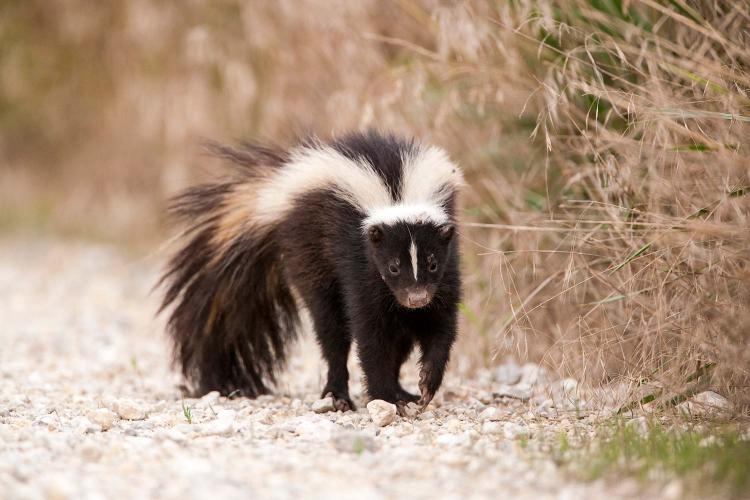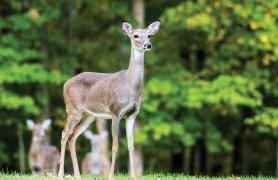The young coyote was hungry — and dumb. It had cornered a cat-sized animal against a fallen log. The animal looked fat and delicious. Yet something about it wasn’t quite right. This was usually the point in the coyote’s attack when prey made a last-ditch attempt to flee. But the little black creature was standing its ground.
Eventually, hunger overpowered the coyote’s wariness. With a yip, the wild dog bared its fangs and leapt forward … directly into a yellowish-green cloud of stink. Suddenly, the predator couldn’t be a predator anymore. Its eyes burned. Its nose stung. And the smell — hoooowwl — the smell was unbearable.
As the coyote ground its head into the dirt, trying in vain to rub the stench from its fur, the little black creature waddled away. It had just taught Missouri’s craftiest predator a lesson it would never forget: Messing with a skunk is a stink you don’t want to raise.
White on Black Means “Stay Back!”
If you were to examine a striped skunk — upwind, from a distance, and wearing a gas mask, of course — you might notice its short legs, its small head, or its bushy tail. But more likely the first thing you’d spot was its black-andwhite fur. The bold stripes act like a warning sign to other animals. They’re how a skunk yells “BACK OFF!” without making a sound.
Skunks aren’t built to avoid predators. For one, they’re terribly near-sighted. A predator could creep within 10 feet of a skunk before it ever took notice. And skunks aren’t speed demons. When pressed, the chubby mammal might waddle off at 8 mph — about as fast as a toddler on a wobbly walk. But why hurry and why worry? After all, nature has equipped skunks with a superpower that makes them nearly predator proof.
Reluctant Warriors
Some skunks — particularly youngsters — are trigger-happy and will let their funk fly at the slightest sign of danger. Most, however, will go to great lengths to warn attackers before unleashing the nuclear option.
If a threat approaches, a skunk often flares out the hairs on its tail like a scared cat. It might stamp its front paws rapidly on the ground, pata- pat-a-pat! It may click its teeth, growl, or hiss. Or it may flip into a handstand and walk around with its tail pointed skyward. This would be adorable except for what usually happens next…
Fighting the Funk
If your dog — or your little brother — happens to get sprayed, you have two options.
- Make them stay outside (preferably downwind) for the next three weeks.
- Fight chemistry with chemistry. Mix together 1 quart of 3 percent hydrogen peroxide, ¼ cup of baking soda, and a tablespoon of dish soap. Lather the concoction into Fido’s fur (or your little brother’s hair) and let it sit a bit. The mixture will react with the stinky chemicals in the skunk spray and turn them into harmless, odorless molecules that you can rinse away.
Whatever you do, don’t soak the victim in tomato juice. It won’t quell the smell. It will just make them smell like skunky spaghetti sauce.
Stink Bomb
If a predator won’t back down, the skunk bends its body into a U shape, so that both its head and its dangerous derrière are pointed toward the attacker. Two fleshy nozzles push out from below the skunk’s tail. Like squirt guns, the nozzles shoot out stinky musk. The spray is so powerful, your nose can detect one molecule of the foul-smelling fluid in a billion molecules of air. In fact, you can catch the whiff of a skunk’s back blast from more than a mile away!
When a skunk is being chased, it can drop a fog of foulness that its chaser must run through. When cornered, a skunk can squirt a stream of stink directly at a predator’s pie hole. In calm weather, the musky mammals can bull’s-eye a target from 10 feet away and get close enough to make a victim hate life from a distance of 20 feet. Even worse, a skunk can fire five or six times before running out of ammo.
Home Sweet Hole
Striped skunks are found throughout Missouri. Although they prefer to live on the edge, in spaces where two kinds of habitats come together, the adaptable animals can be found nearly anywhere, even urban backyards.
During the day, skunks usually sleep in an underground den. Sometimes a skunk digs its own skunk hole, but usually it uses the abandoned burrow of another mammal, such as a woodchuck or fox. Skunks carry leaves inside their dens to build comfy, cozy beds.
Furry Vacuum Cleaners
Wherever they roam, skunks act like furry vacuum cleaners that hoover up anything they come across. This includes fruits, grains, worms, moles, shrews, baby bunnies, eggs — even garbage and dead animals. But their favorite foods are creatures that most people consider to be pests: insects and rodents.
Their love of food can get them in trouble. Skunks sometimes leave lawns pockmarked with holes from digging up creepy-crawlies to eat. If pet food is left outside, a skunk will happily gobble up the free meal and defend it — with stinky effect — from its rightful owner. And skunks have been known to tear into trash bags like they were sacks of Halloween candy.
Missouri’s Other Skunk
Though striped skunks are far more common, Missouri is home to another flavor of skunk: the eastern spotted skunk. Smaller than their striped cousins, spotted skunks scamper rather than waddle and are agile enough to climb trees. In most of the U.S., spotted skunks prefer open prairies and brushy fields. But in Missouri, they’re most likely to be found in Ozark woodlands.
Spotted skunks were once common in the Show-Me State, but in the 1940s they all but disappeared. Today, spotted skunks are rare. If you’re lucky enough to spot one, please call your local Conservation Department office to report where you saw it.
Snuggle Buddies
In autumn, skunks pack on pounds. The fat helps them survive winter weather. When temperatures drop, the chubby eating machines retire to their dens for winter naps that can last for weeks. During this time, several skunks may gather in the same den for warmth. They even join other animals, such as woodchucks, opossums, and rabbits. As many as 20 skunks have been found snuggled together in a single den.
Spring Speed Bumps
The most likely month to catch a whiff of skunk funk is March. This is when skunks wake from their long winter naps hungry for food — and for love. Mate-crazed males wander widely to find females, and many of the near-sighted Romeos get pancaked when they cross highways.
Little Stinkers
Although their boyfriends leave after just a few days, girl skunks aren’t lonely for long. By May, females are busy turning their dens into nurseries. There, they give birth to a litter of four to eight babies.’
At birth, the kitten-sized kits are blind, toothless, and nearly hairless, but their skin shows the iconic black-and-white markings. After two weeks of drinking mom’s milk, the kits are fully furred. A few days later, their eyes squint open. And a month after that, mom takes her little stinkers — now armed and dangerous — out for their first nighttime hunts. The family stays together until fall. Then, the youngsters strike out to be fabulously funky on their own.










Also In This Issue

This Issue's Staff
Les Fortenberry
Karen Hudson
Angie Daly Morfeld
Noppadol Paothong
Marci Porter
Mark Raithel
Laura Scheuler
Matt Seek
David Stonner
Nichole LeClair Terrill
Stephanie Thurber
Cliff White






















